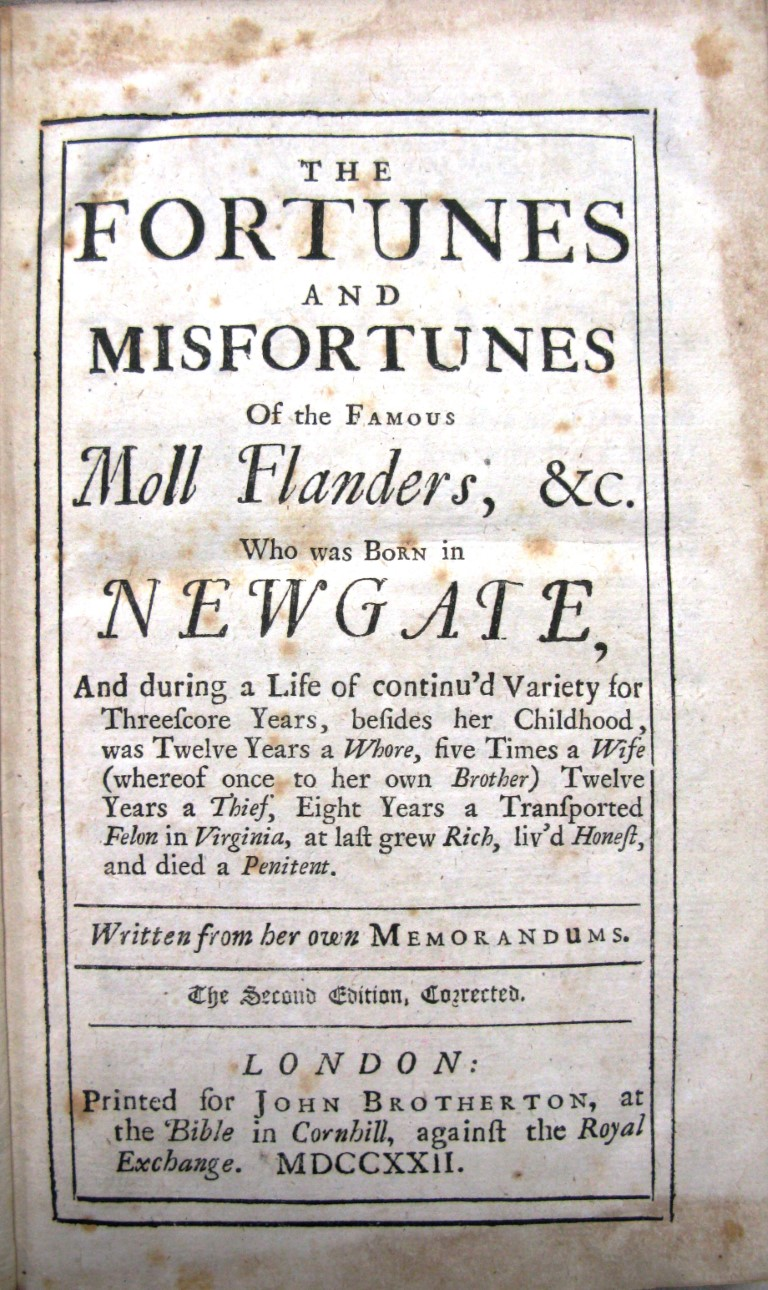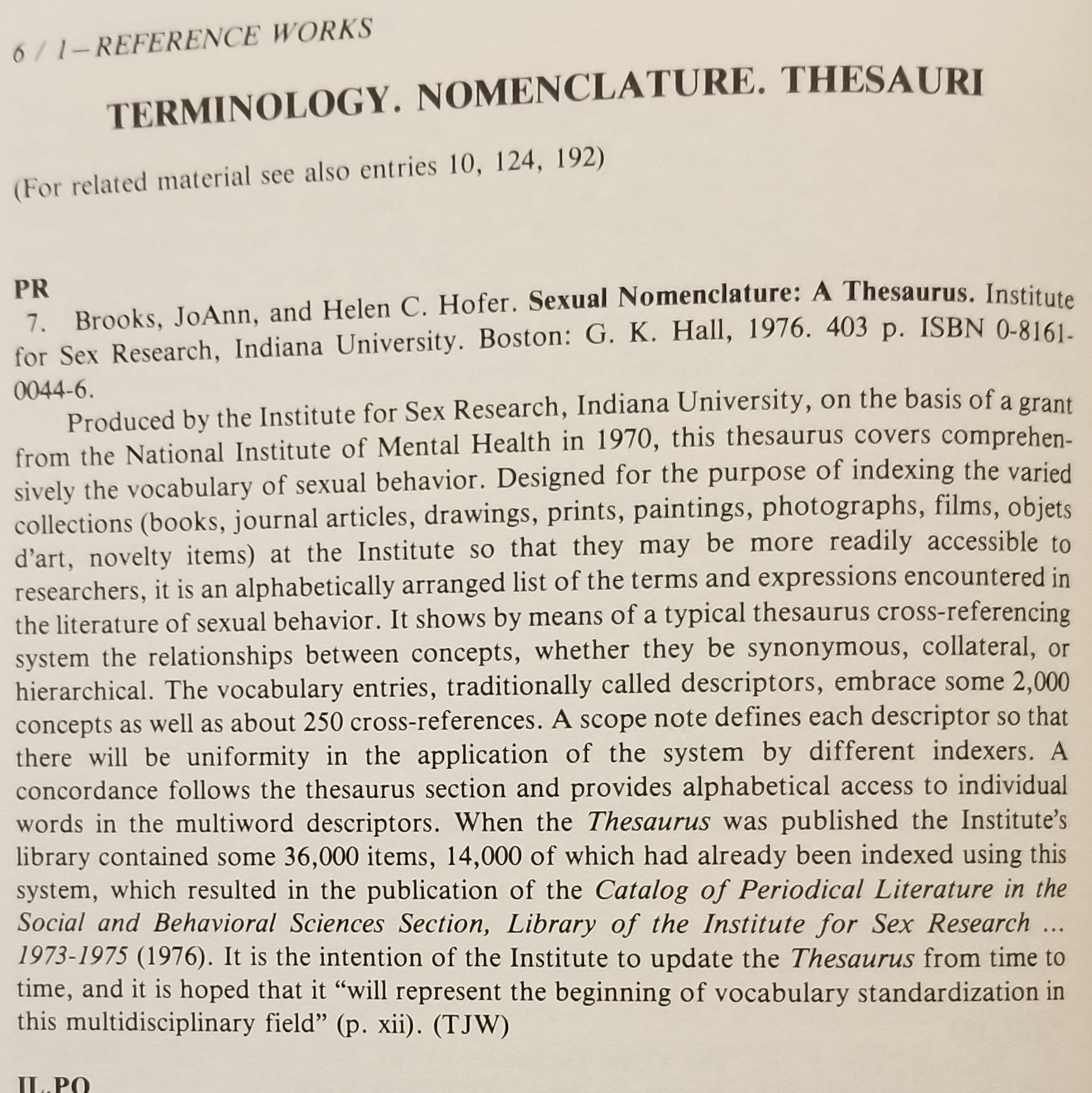The History of Sexual Nomenclature, a Thesaurus
p.s. The title of this post is a riff on Moll Flanders

The literature on Sexual Nomenclature: A Thesaurus is quite sparse, despite how important it is—or at least how important I obviously think it is—my PhD applications were predicated on that thought!
In the literature there are about a half dozen references to SNT in various bibliographies on sexuality or lists about thesauri.
Here’s a typical example, from Frayser and Whitby’s Studies in Human Sexuality: A Selected Guide (1987) discussing SNT:

Indeed, there are only two authors that have written on the organization of the library:
-
Liana Zhou, the current Director of the Library & Special Collections, and
-
Donna Drucker, Senior Adviser in English as the Language of Instruction at Technische Universität Darmstadt, Germany. She is the author of two fantastic books:
- The Classification of Sex: Alfred Kinsey and the Organization of Knowledge and
- The Machines of Sex Research: Technology and the Politics of Identity, 1945–1985.
This will just be a brief way to touch on various aspects of both of the works and how they talk about SNT. Both in the final paper and in the below I will examine their articles at a greater depth than is usual, due to this lack of study.
The First Era: Kinsey’s
The beginning of Kinsey Institute Library and Special Collections was also the beginning of the Kinsey Institute itself—Alfred Kinsey listed it as a ‘requirement’ in the founding documents of the institute. He also donated his book collection along with his own private categorization system.
As Zhou discusses at (super fascinating detail), Kinsey’s original cataloging used
A for Artists, AC for Art Collections, AP for Art and Photography, BL for Bibliography, BM for Biology and Medicine, D for Dictionary, E for Erotica, F for pre-twentieth century Fiction, EM for Erotic Manuscripts, GA for gallant literature, PO for Poetry, SH for Social history, WL for Women and love, and Gen for general works, including essays, humor, censorship, etc.
French and German books, which made up a large portion of the collection, were incorporated into the general scheme, “while European-language materials were incorporated into his general scheme, Asian materials were coded as OR-C for Chinese erotica, OR-J for Japanese erotica, and so forth. "
Like his gall wasps, Kinsey made a little card for each book that identifying it by general subject, author (if any), and title, for both English and other languages.
The Second Era: Dewey’s
Although there were a number of staff members and librarians before the 1960s, it was only in the 1960’s that Elizabeth Egan applied a classification system to the KILB collection. Although I don’t know the details of why she chose DDC, it is likely because LCC was a much more complex system to work with and would not have been as flexible—but it also could have just been her own experience. Thanks to Zhou again, we have a discussion of how DDC is used.
Class numbers 0XX to 4XX were used like so:
class number 0XX was assigned for general topics, 1XX for psychological, cultural, and attitudinal aspects of sexuality, 2XX for religious aspects, 3XX for legal, educational, or research methodology and prostitution, and 4XX for languages, linguistics, and sexuality.
The 500’s are the most commonly used numbers in the KI collections, as they bring together all of the material on sexual behaivour. There is still a amusing amount of creativity though! For example:
532 for homosexuality, 532.09 for history of homosexuality, 532.18 for case studies on homosexuality research, 532.8 for female homosexuality but not to include any popularized case studies, 538 for transvestitism, and 54X for sadomasochism.
The 600’s are used for medical aspects of sexuality (e.g. “613 for family planning, population, and eugenics, 617 for AIDS and sexual behavior”), and the 700’s are where the most valuable items are, i.e. “704 for collections and anthologies of themes in art and mythology and legend as portrayed in art, 704.69 [nice] for sadomasochism in art.”
It is in the 800s (finally) that we get what we’re all here for—the articles! No, kidding:
Class 8XX is used for erotic literature–a large and most complex collection of 14,000 items. The table of classification for this section is further extended chronologically, by language or literary format. For instance, 803 is for dictionaries and encyclopedias that are not limited to any specific language, 808 for collections of literary criticism from various languages, 808.07 for collections from various languages of the nineteenth century, 808.7532 for collections from multiple languages on homosexuality, 820 for English-language erotic literature (including 820.3 for dictionaries and encyclopedias), 821 for collections of poems by multiple poets, 822 for works of drama, 822.3 for individual fifteenth century playwrights, 823 for collections of erotic fiction, 823.8 for fiction of individual twentieth century authors, 830.3 for German erotica, 840 for French-language literature, 870.3 for Latin-language literature, and 880.3 for Greek-language literature. For anonymous works, of which there are many, the period of composition is considered when assigning a classification number.
The Third Era: The Sexonomen
According to Zhou, as well as Drucker, the 1970’s was when DDC began to wobble and threaten to break apart (honestly, lots of things broke in the 70s, I get it). The 70’s also sae the increasing use of controlled vocabularies and institute-specific thesauri. Standards for these were developed and published, and a draft of the American National Standard: Guidelines for Thesaurus Structure, Construction, and Use (ANSI Z39.19-1974) became available.
The latter is what SNT is based on. After a successful grant from the National Institute of Mental Health (who had their own reasons for wanting the KI’s collection better managed), JoAnne Brooks and Helen Hofer were put in charge of developing the thesaurus. They drew on all the earlier systems, but developed them logically within the ANSI standards. One example of that is cited by Drucker:
One key difficulty was in establishing terms both familiar and yet nonjudgmental, in the Kinseyan tradition. For example, “Erotica” covered a wide range of materials, some intended to sexually stimulate the reader or viewer, while “Pornography,” a narrower term, was freighted with moral and legal connotations. Similarly, Dixon and Beasley chose “Sex Variations” rather than “Sex Deviations” or “Sexual Deviance” to indicate behaviors that were outside the statistical norm.
As Drucker has explained, citing head librarian Rebecca Dixon:
Even though sex research had greatly expanded, researchers lacked basic tools available to researchers in other fields until the catalogs and thesaurus were published. “Researchers in any one area, such as psychology, usually tapped only the resources that existed in their own area,” librarian Rebecca Dixon said. “Now a psychologist doing research can know what the sociologist, the anthropologist and other researchers are doing in the field as well.” The catalogs helped facilitate the kind of multidisciplinary study so valued by Kinsey from the outset of his devising the collections while also manifesting the field’s scholarly infrastructure.
The Fourth Era: Revise and Resubmit
As we discussed last time, however, thesauri are difficult to maintain, and require constant maintenance and labor. Although Sexual Nomenclature remains in use in cataloging at the Kinsey Institute, it is beginning to show signs of its age. KILIB staff, according to Drucker last updated Sexual Nomenclature’s terms in December 2015, but several changes still remain (this my project!).
Drucker offers some critique of the thesaurus, which I drew upon for my project, but this post is already on the longer side, so I will add this in the full paper, and close with this quote from Zhou:
The library and archives stand as an enduring monument to Kinsey’s lifetime of devotion to his work . . . [The] Institute has spent its own funds, saved from book royalties and fees, and it also depends heavily on donors, as it did when Kinsey was alive . . . Anything that is relevant to human sexuality in any way merits consideration for possible inclusion. In addition to virtually all scientific works on human sex research, numerous specialized fields are strongly represented, including physiology, abortion, sex law, prostitution, psychology, marriage counseling and many other related topics. Nonscientific published materials, such as popular books and articles, are included. The Institute has . . . the largest collection of erotic literature assembled in any one place.
That’s all for now!